|
Himantopus himantopus
(Black-winged stilt)
Rooipootelsie [Afrikaans]; Mamenotoana-nala [South Sotho];
Steltkluut [Dutch]; Échasse blanche [French]; Stelzenläufer [German];
Perna-longa [Portuguese]
Life
> Eukaryotes >
Opisthokonta
> Metazoa (animals) >
Bilateria >
Deuterostomia > Chordata >
Craniata > Vertebrata (vertebrates) > Gnathostomata (jawed
vertebrates) > Teleostomi (teleost fish) > Osteichthyes (bony fish) > Class:
Sarcopterygii (lobe-finned
fish) > Stegocephalia (terrestrial
vertebrates) > Tetrapoda
(four-legged vertebrates) > Reptiliomorpha > Amniota >
Reptilia (reptiles) >
Romeriida > Diapsida > Archosauromorpha > Archosauria >
Dinosauria
(dinosaurs) > Saurischia > Theropoda (bipedal predatory dinosaurs) >
Coelurosauria > Maniraptora > Aves
(birds) > Order: Charadriiformes
> Family: Recurvirostridae
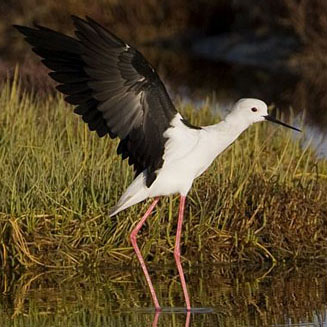 |
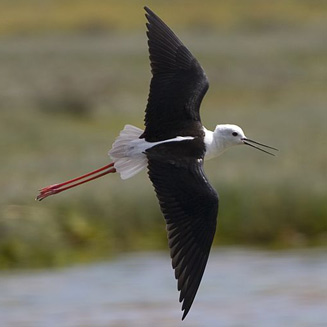 |
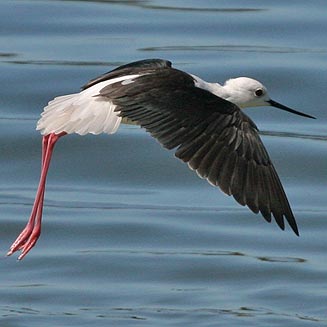 |
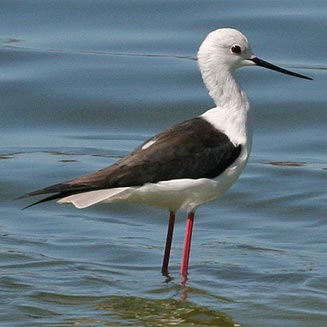 |
| Top left: Black-winged stilt, West Coast National Park,
South Africa. [photo Trevor Hardaker ©]
Bottom right: Black-winged stilt, Strandfontein
Sewerage Works, Western Cape, South Africa. [photo
Duncan Robertson
©] |
Top right: Black-winged stilt, West Coast National Park,
South Africa. [photo Trevor Hardaker ©]
Bottom right: Black-winged stilt, Strandfontein
Sewerage Works, Western Cape, South Africa. [photo
Duncan Robertson
©] |
Distribution and habitat
Its distribution stretches across the world between 50°
North and 40° South, including in sub-Saharan Africa, absent from the
forests of the DRC and Angola. In southern Africa it is common across much of the region, largely
excluding southern Botswana, Zimbabwe, much of Mozambique and south-eastern
South Africa. It generally prefers inland and coastal wetlands, such as
commercial salt pans, flooded fields, flood plains, papyrus swamps and sewage
works.
|
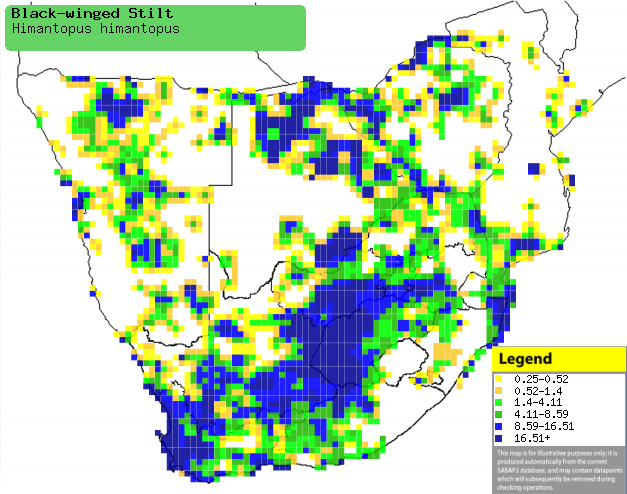 |
|
Distribution of Black-winged stilt in southern Africa,
based on statistical smoothing of the records from first SA Bird Atlas
Project (©
Animal Demography unit, University of
Cape Town; smoothing by Birgit Erni and Francesca Little). Colours range
from dark blue (most common) through to yellow (least common).
See here for the latest distribution
from the SABAP2. |
Predators and parasites
- Predators of chicks and eggs
Movements and migrations
Little known, it is thought to be a nomad and
partial migrant, moving in search of recently flooded temporary
pans; it is also a breeding migrant to Zambia, staying there from
about April-November.
Food
It mainly eats insects, other invertebrates and fish, doing
most of its foraging by locating prey visually before plucking them from the
water surface, or by immersing its head in the water while locating prey with touch. The following food items have been recorded
in its diet:
- Invertebrates
- insects
- small gastropods
- polychaetes
- crustaceans
-
spiders
- Vertebrates
- tadpoles
- amphibian eggs
- fish and their eggs
Breeding
- Monogamous, usually solitary nester, although it may occasionally breed in
loose colonies of about 5-10 pairs.
- The nest (see image below) is built by both sexes, consisting of a mound
of mud usually with incorporated pieces of material, such as Waterweed (Potamogeton
pectinatus), oxygen weed (Lagarosiphon), Kariba weed (Salvinia
molesta) and often decorated with mollusc shells. It is typically placed
on damp mud, mats of vegetation or some other structure at the edge of the
waterline.
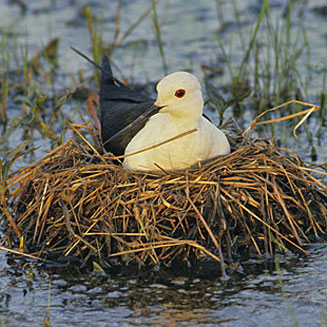 |
 |
|
Black-winged stilt incubating its eggs, Nylsvley,
South Africa. [photo Warwick Tarboton ©] |
Black-winged stilt chick, Rocher Pan,
South Africa. [photo Trevor Hardaker ©] |
- Egg-laying season is year-round, peaking from January-July in Botswana and
Namibia and from about August-December elsewhere in southern Africa.
- It lays 2-5 eggs, which are mainly incubated by the female for about
24-27 days, although the nest is often left unattended on cool or overcast
days.
- The chicks leave the nest and are capable of self-feeding with 24 hours
of hatching, taking their first flight at about 28-32 days and becoming
fully independent about 14-28 days later.
Threats
Not threatened.
References
-
Hockey PAR, Dean WRJ and Ryan PG 2005. Roberts
- Birds of southern Africa, VIIth ed. The Trustees of the John Voelcker
Bird Book Fund, Cape Town.
|
